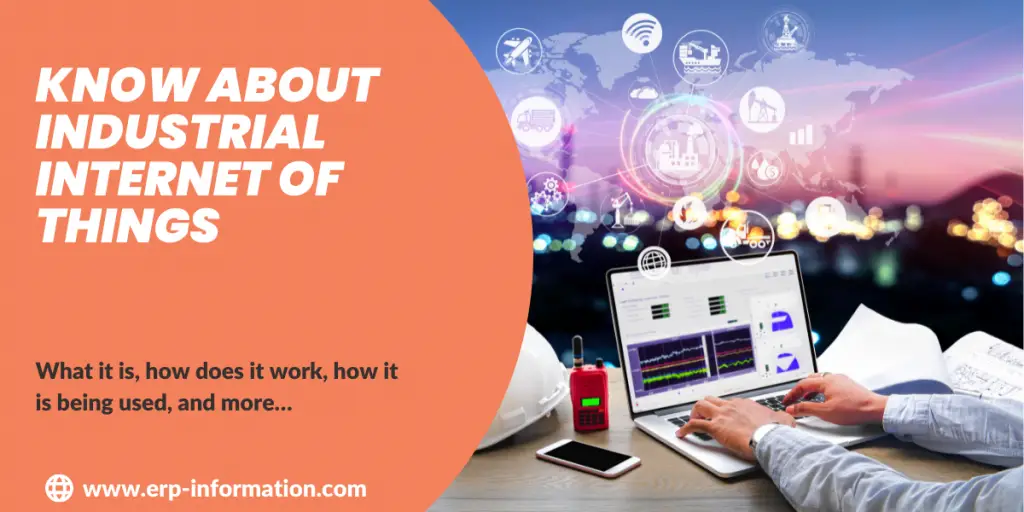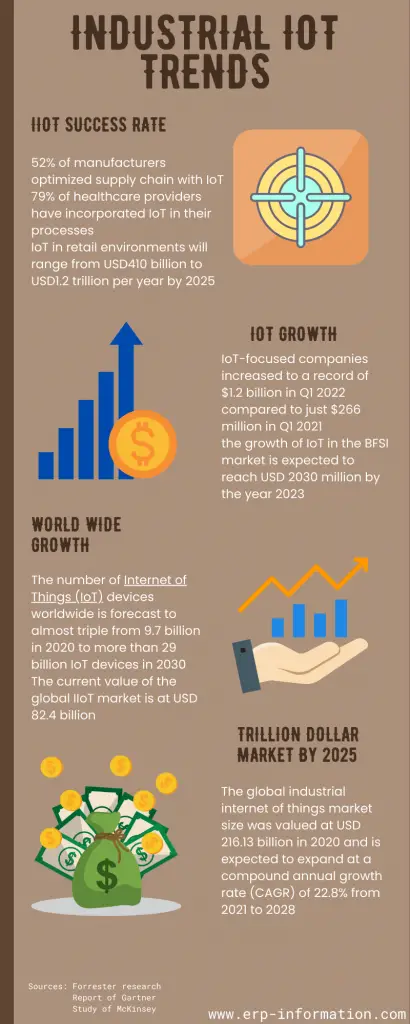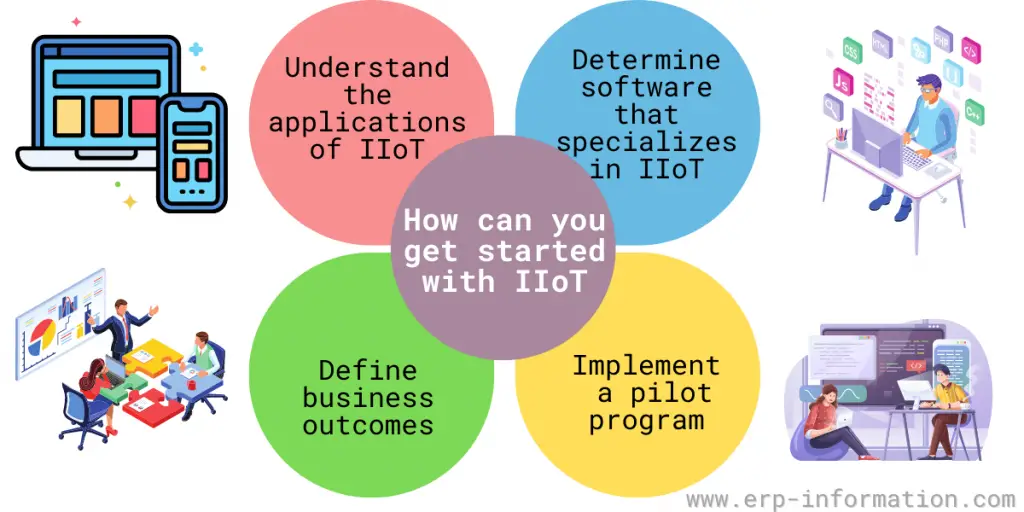The industrial internet of things (IIoT) is a term often heard in business and technology circles, but what does it mean?
This term describes the network of physical objects, including machines, devices, vehicles, and even buildings, that are connected to the internet and can share data.
This network of connected things has the potential to revolutionize how businesses operate by increasing efficiency, reducing costs, and improving safety.
The Industrial IoT is still in its early stages, but there are several examples of how it is used in industry. In the future, industrial IoT is expected to impact the economy and society significantly.
This post will examine what IIoT is, its use, and what the future holds for this transformative technology.
IIoT definition
It is a term that describes the application of Internet-of-Things (IoT) technologies in industrial settings. It is a subset of the IoT, which connects physical objects (devices, vehicles, buildings, etc.) to the internet.
While the IoT can be applied in various industries, it refers explicitly to using IoT operational technology in manufacturing, supply chain, logistics, and other industrial operations.
The IIoT has the potential to revolutionize the way industrial operations. By connecting machines and devices to the internet, companies can collect data on their performance in real-time. This data can optimize processes, improve safety, and reduce costs.
In addition, it can enable companies to create new business models and services that were impossible before.
IIoT devices interact with our environment by connecting everyday objects to each other. With wireless sensors, actuators, software applications, computers, and machines used in agriculture or any manufacturing industry and automotive industry.
The internet connected devices can communicate vital data from one device to another.
How does it work?
This emerging field connects machines and devices to the internet, allowing them to collect and exchange data. This data can improve efficiency, increase productivity and optimize resources.
These comprise three main components: IIoT devices, connectivity, and analytics.
- First, IIoT devices are connected to the internet and collect data transmitted via connectivity.
- Finally, analytics are used to interpret this data and provide insights that can be used to improve operations.
How is IIOT being used in industry today?
Industrial IoT allows machines and devices to communicate with one another and with systems operators, making it possible to monitor and control them remotely. The smart devices of industrial IoT are used in various industries today, including manufacturing, transportation, and healthcare.
Manufacturing
Manufacturing companies are using IIoT to connect machines on the factory floor and collect data on their performance. This data can be used to improve product quality and operational efficiency. In addition, connecting machines to the internet can help companies detect and diagnose problems more quickly.
Supply chain
The IIoT tracks goods as they move through the business logistics. This data can optimize inventory levels, reduce losses, and improve customer service.
Transportation
It is being used to track vehicles and optimize routes. This data can be used to reduce fuel consumption and traffic congestion.
Healthcare
It connects medical devices and shares data with patients and doctors. This data can be used to improve patient care and safety.
What are the benefits of Industrial Internet of Things?
There are many potential benefits, including:
- Improved efficiency: Businesses can efficiently collect data and automate processes. The IIoT uses Artificial intelligence objects to gather information from machines and save it.
- Improved quality control: By monitoring processes and equipment, businesses can catch problems early and improve the quality of their products.
- Increased flexibility: Businesses can quickly adapt to changes in demand or production by reconfiguring their systems.
- New business models: The industrial internet of things opens up new opportunities for businesses to offer services and products.
- Reduced operational costs: Businesses can lower operating costs by automating processes and reducing waste.
Challenges
Despite the potential benefits, there are also some challenges associated with it, including:
- Security: The industrial IoT relies on data communication, which means businesses need to be aware of the potential for cyber-attacks.
- Interoperability: The IIoT relies on devices and systems from different manufacturers working together. That can be a challenge if there are compatibility issues.
- Privacy: The industrial IoT collects data about people and businesses. That raises concerns about privacy and the potential for misuse of data.
How can you get started?
Understand the different applications of the IIoT
Understand different applications and how they can be used in your specific industry. Once you have a clear idea, you can start looking for particular products and services that will help get you started. In addition, several online resources and training programs are available to help you get started.
Find a company specializing in IIoT
This can be done by searching online or contacting your local Chamber of Commerce. Once you have found a company, you can schedule a consultation to discuss your specific needs and how they can be met.
Define business outcomes and ROI
Once you clearly understand how IIoT can benefit your business, you must set some goals. These goals will help you determine whether or not the IIoT is right for your business and how much it will cost.
Implement a pilot program
This will allow you to test the IIoT and see how it works in your specific business environment. It will also allow you to ensure everything works correctly before rolling it out to your entire operation.
Difference between IoT and IIoT
The use of these two will be the same, like cloud platforms, sensors, connections, machines talking to other devices, and data analysis. Some major difference is listed below.
IoT
- IoT devices are in many places like farms, hospitals, homes, and cities. IoT devices can be things like washing machines or fitness trackers that don’t endanger people if something goes wrong.
IIoT
- IIoT applications connect machines and devices in factories, power plants, and oil rigs. If these systems break down, it can be very dangerous. These applications are designed to keep people safe and make things more efficient.
Some the companies
- Siemens
- Honeywell
- Hitachi
- Augury
- Rockwell automation
FAQs
How can industries overcome security issues associated with IIoT?
Industries can overcome security issues associated with IIoT by ensuring they have the proper security protocols. That includes using strong passwords, encrypting data, and firewalls to protect against cyber attacks. Additionally, industries should regularly update their software and security measures to ensure they are as protected as possible.
What is the future of the Industrial Internet of Things?
The industrial IoT is still in its early stages, and it is difficult to predict precisely how it will develop. This has the potential to revolutionize the way businesses operate. As more companies adopt this technology, we will likely see more changes and innovations.
Conclusion
The industrial internet of things is a term used to describe the fourth industrial revolution, characterized by blurring the lines between the physical, digital, and biological worlds.
This encompasses all aspects of industry 4.0, including cyber-physical systems, cloud computing, the internet of things, and big data analytics.
By bringing together these Industry 4.0 technologies, the IIoT has the potential to revolutionize manufacturing, supply chains, and many other industries.
This post has introduced the industrial internet of things and its uses.
References


